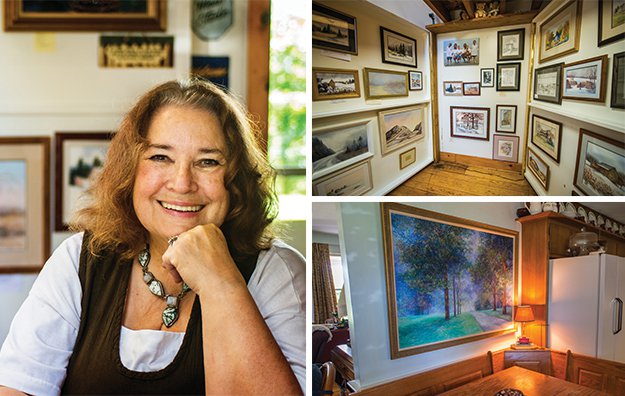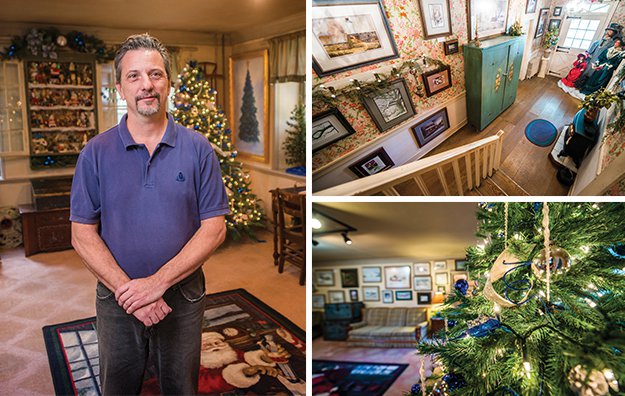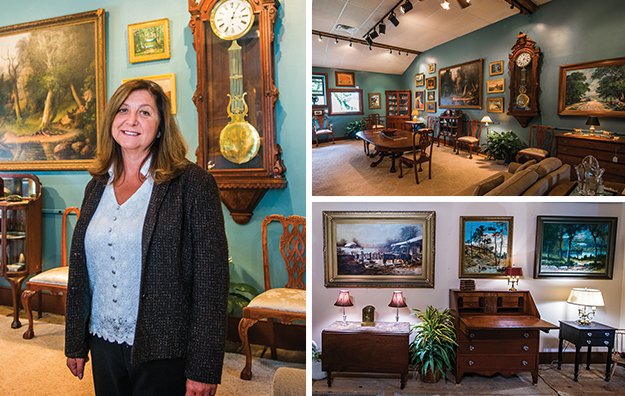Buying, selling and owning original art has its big and small rewards. Why, you ask? According to experts, all good work increases in value over time, but like most speculative investments, it depends on the market. What’s most important is that you buy something that you love and can afford because even a limited edition print (one that the artist has personally signed and numbered) has the potential to be worth more than what you might have paid for it.
Get it while the paint’s still wet! Local scenic art, one, two or three generations old is hot and in high demand, not just for its resale value. Truth is, most buyers consider this kind of specialized art an investment in the memories of their childhood — of the look and feel of country roads and rural structures that have been around for ages.
But before you buy, it always helps to know a little about the artist.
AT HOME WITH ARTIST JULIE LONGACRE
An 80-year-old trumpet creeper vine — as thick and wide as an old tire on a pickup truck — grows tangled on a trellis that marks the entranceway to the home of renowned Berks County artist Julie Longacre. Dressed in a long blue smock with matching pants and a white short-sleeved shirt, Julie, 71, exudes country charm. For our interview, she is wearing her wavy brown hair pulled back and a short strand of white pearls around her neck. Julie and her husband Newton “Newt” Longacre, part-owner of Longacre’s Dairy, live just a stone’s throw away from the popular ice cream eatery along Route 100 in Barto.
Julie is devoted to her art, her two grown sons – Newt, Jr. and Jake “Jason” – and her seven grandsons. The boys like to play on two pump organs and with an old Lionel train set that belongs to Newt Sr., who is an avid collector, when they come to visit. The set is up year-round on a table top in the living room. It comes as no surprise when the artist tells me she does not live in a designer house. She calls it her “working” home.
A CUSTOM-DESIGNED STUDIO
An easel (a gift from Julie’s artist friend, the late Jack Coggins), vintage cooking stove and large, round wooden table with chairs add warmth and rustic charm to this custom-designed room. Natural light pours in from a glass sliding door with three panels as well as from several long vertical windows and skylights. Intricate carvings on a wooden baluster on the second floor reveal the artist’s love of hearts, angels and teardrops. A good portion of Julie’s work is displayed in this room on two eight-foot panels that open like pages in a book.
HOMEGROWN TALENT
Julie, who was born in Reading and grew up in Gilbertsville, began drawing when she was around 10 years old. “I painted what I saw,” she says about the country scenes often depicted in her early work.
“I try to capture the emotional aspect of nature and structures that are mostly rural,” continues Julie, who is also known for her floral watercolors. She holds a degree in fine art from Bethany College, Lindsborg, Kansas.
A PROLIFIC ARTIST
Julie has sold in the neighborhood of about 4,000 paintings since starting her career, she tells me. At its height, she was creating at least 300 drawings, paintings and illustrations a year.
Her custom Christmas card line is still growing. It started in 1969, after a drawing of the family’s walk-in fireplace. The cards — about 10,000 to 15,000 a year — are bought by local companies and marketed up and down the east coast.
Julie is often commissioned by private individuals, corporations, organizations, churches, parks, historic sites and hotels. She spends most of her time painting and writing at her home in Barto. She can also be found working in Port Hood, Nova Scotia, where she owns her second studio.
COLLECTING AND DISPLAYING ART
Julie owns original work by both local and national artists.
“I've always been a collector, especially that of people whom I've been acquainted with,” says Julie, who in the past would swap work with other artists at shows. At exhibits, she says, she sometimes would manage to acquire a print when an original was out of her price range.
Of course, she has some of her own best work on the walls in her home. For instance, a small mirror in the living room reflects an original painting in the kitchen across the room. The large, scenic oil painting — a path lined with tall trees in full bloom on a lush green lawn — pulls you in. Julie is a big fan of big art in small places.
Her canvas work is framed, but it is never put under glass. Her watercolors and prints are without glass, too. “I personally do not want to see my reflection when I look at a piece of artwork,” she shares.
On another wall, a painting of Julie holding a guitar takes center stage above an heirloom pump organ. The portrait was painted by Coggins in the mid-1970s when the two were members of the Art Alliance in Reading.
For a better idea of the present value of an early original by Julie, we look at an old business ledger (from 1973) that lists a painting that had sold for $40. Today it might sell for anywhere from $1,500 to $3,000, depending on size and subject, Julie shares.
Julie’s three books The Dirty Old Ladies Cookbook, The Place I Keep and A Sketch in Time – in addition to her cards, prints and giclées – are available on her website at julielongacre.com and at Longacre's Dairy.
FRAME IT
Twenty-three years ago, Gary K. and Shelly K. Rotenberger of Garshell Art & Frame, Gilbertsville, specialized in only wildlife art. A year later, they changed their business plan. “It seemed people were coming in for all local,” shares Gary, who over the years has developed a feel for what sells in this area. The gallery has approximately 100 originals and prints, give or take, by Berks County artists. They also offer custom hand-carved furniture and mirrors in addition to providing antique frame restorations and custom picture framing.
EXPERT ADVICE
While it’s sometimes necessary to reframe artwork to fit one’s home décor, Gary says, an antique piece (about 100 years old) will hold its value better in its original frame.
For oils (anything on canvas) he suggests putting a frame around the work. If it’s a watercolor, acrylic or pastel (anything on paper), it’s best to put the work under glass, though you never want the glass touching the artwork.
This holiday, the gallery is offering framed prints in the $250 to $300 range, Gary says. “We have a good variety of winter scenes of farm houses and barns under a blanket of snow,” he says. “The scenes have a Christmas feel to them but look good all year long.”
Kurt and Valerie Malmberg, owners of Greshville Antiques and Fine Art in Boyertown, specialize in local art by Christopher H. Shearer, Frederick Spang, Earl L. Poole and others from the 19th and 20th centuries. In addition, they specialize in American and European clocks and American furniture from the 1780s through the 1920s.
They only sell work by deceased artists. This alone sets the gallery apart from most other art outlets.
“Since an artist is no longer producing, a true secondary market is created, with limited supply available to fulfill an increasing demand,” explains Valerie, who for more than 25 years has been researching, identifying, appraising, buying and selling Berks County Art™.
Her interest in original local art began many years ago with the purchase of an antique print of a hen with her brood of chicks, she says. Unfamiliar with the artist (in this case it was Ben Franklin Austrian, 1870-1921), she started an extensive search for information.
“That artwork changed my life,” says Valerie, who was 19 at the time and busy raising two toddlers.
Today, Valerie assists auction houses, institutions, appraisers and collectors in evaluating and purchasing regional art.
She encourages art buyers to visit museums and institutions to expose their eyes to samples of local work. The Reading Public Museum and Art Gallery and the Historical Society of Berks County both have fabulous collections, she suggests.
Garshell Art & Frame2109 Big Rd., Gilbertsville
610.754.6424
garshellart.com
Greshville Antiques and Fine Art
1041 Reading Ave.,Boyertown
610.367.0076
greshvilleantiques.com
Buying, selling and owning original art has its big and small rewards. Why, you ask? According to experts, all good work increases in value over time, but like most speculative investments, it depends on the market. What’s most important is that you buy something that you love and can afford because even a limited edition print (one that the artist has personally signed and numbered) has the potential to be worth more than what you might have paid for it.
Get it while the paint’s still wet! Local scenic art, one, two or three generations old is hot and in high demand, not just for its resale value. Truth is, most buyers consider this kind of specialized art an investment in the memories of their childhood — of the look and feel of country roads and rural structures that have been around for ages.
But before you buy, it always helps to know a little about the artist.
AT HOME WITH ARTIST JULIE LONGACRE
An 80-year-old trumpet creeper vine — as thick and wide as an old tire on a pickup truck — grows tangled on a trellis that marks the entranceway to the home of renowned Berks County artist Julie Longacre. Dressed in a long blue smock with matching pants and a white short-sleeved shirt, Julie, 71, exudes country charm. For our interview, she is wearing her wavy brown hair pulled back and a short strand of white pearls around her neck. Julie and her husband Newton “Newt” Longacre, part-owner of Longacre’s Dairy, live just a stone’s throw away from the popular ice cream eatery along Route 100 in Barto.
Julie is devoted to her art, her two grown sons – Newt, Jr. and Jake “Jason” – and her seven grandsons. The boys like to play on two pump organs and with an old Lionel train set that belongs to Newt Sr., who is an avid collector, when they come to visit. The set is up year-round on a table top in the living room. It comes as no surprise when the artist tells me she does not live in a designer house. She calls it her “working” home.
A CUSTOM-DESIGNED STUDIO
An easel (a gift from Julie’s artist friend, the late Jack Coggins), vintage cooking stove and large, round wooden table with chairs add warmth and rustic charm to this custom-designed room. Natural light pours in from a glass sliding door with three panels as well as from several long vertical windows and skylights. Intricate carvings on a wooden baluster on the second floor reveal the artist’s love of hearts, angels and teardrops. A good portion of Julie’s work is displayed in this room on two eight-foot panels that open like pages in a book.
HOMEGROWN TALENT
Julie, who was born in Reading and grew up in Gilbertsville, began drawing when she was around 10 years old. “I painted what I saw,” she says about the country scenes often depicted in her early work.
“I try to capture the emotional aspect of nature and structures that are mostly rural,” continues Julie, who is also known for her floral watercolors. She holds a degree in fine art from Bethany College, Lindsborg, Kansas.
A PROLIFIC ARTIST
Julie has sold in the neighborhood of about 4,000 paintings since starting her career, she tells me. At its height, she was creating at least 300 drawings, paintings and illustrations a year.
Her custom Christmas card line is still growing. It started in 1969, after a drawing of the family’s walk-in fireplace. The cards — about 10,000 to 15,000 a year — are bought by local companies and marketed up and down the east coast.
Julie is often commissioned by private individuals, corporations, organizations, churches, parks, historic sites and hotels. She spends most of her time painting and writing at her home in Barto. She can also be found working in Port Hood, Nova Scotia, where she owns her second studio.
COLLECTING AND DISPLAYING ART
Julie owns original work by both local and national artists.
“I've always been a collector, especially that of people whom I've been acquainted with,” says Julie, who in the past would swap work with other artists at shows. At exhibits, she says, she sometimes would manage to acquire a print when an original was out of her price range.
Of course, she has some of her own best work on the walls in her home. For instance, a small mirror in the living room reflects an original painting in the kitchen across the room. The large, scenic oil painting — a path lined with tall trees in full bloom on a lush green lawn — pulls you in. Julie is a big fan of big art in small places.
Her canvas work is framed, but it is never put under glass. Her watercolors and prints are without glass, too. “I personally do not want to see my reflection when I look at a piece of artwork,” she shares.
On another wall, a painting of Julie holding a guitar takes center stage above an heirloom pump organ. The portrait was painted by Coggins in the mid-1970s when the two were members of the Art Alliance in Reading.
For a better idea of the present value of an early original by Julie, we look at an old business ledger (from 1973) that lists a painting that had sold for $40. Today it might sell for anywhere from $1,500 to $3,000, depending on size and subject, Julie shares.
Julie’s three books The Dirty Old Ladies Cookbook, The Place I Keep and A Sketch in Time – in addition to her cards, prints and giclées – are available on her website at julielongacre.com and at Longacre's Dairy.
FRAME IT
Twenty-three years ago, Gary K. and Shelly K. Rotenberger of Garshell Art & Frame, Gilbertsville, specialized in only wildlife art. A year later, they changed their business plan. “It seemed people were coming in for all local,” shares Gary, who over the years has developed a feel for what sells in this area. The gallery has approximately 100 originals and prints, give or take, by Berks County artists. They also offer custom hand-carved furniture and mirrors in addition to providing antique frame restorations and custom picture framing.
EXPERT ADVICE
While it’s sometimes necessary to reframe artwork to fit one’s home décor, Gary says, an antique piece (about 100 years old) will hold its value better in its original frame.
For oils (anything on canvas) he suggests putting a frame around the work. If it’s a watercolor, acrylic or pastel (anything on paper), it’s best to put the work under glass, though you never want the glass touching the artwork.
This holiday, the gallery is offering framed prints in the $250 to $300 range, Gary says. “We have a good variety of winter scenes of farm houses and barns under a blanket of snow,” he says. “The scenes have a Christmas feel to them but look good all year long.”
Kurt and Valerie Malmberg, owners of Greshville Antiques and Fine Art in Boyertown, specialize in local art by Christopher H. Shearer, Frederick Spang, Earl L. Poole and others from the 19th and 20th centuries. In addition, they specialize in American and European clocks and American furniture from the 1780s through the 1920s.
They only sell work by deceased artists. This alone sets the gallery apart from most other art outlets.
“Since an artist is no longer producing, a true secondary market is created, with limited supply available to fulfill an increasing demand,” explains Valerie, who for more than 25 years has been researching, identifying, appraising, buying and selling Berks County Art™.
Her interest in original local art began many years ago with the purchase of an antique print of a hen with her brood of chicks, she says. Unfamiliar with the artist (in this case it was Ben Franklin Austrian, 1870-1921), she started an extensive search for information.
“That artwork changed my life,” says Valerie, who was 19 at the time and busy raising two toddlers.
Today, Valerie assists auction houses, institutions, appraisers and collectors in evaluating and purchasing regional art.
She encourages art buyers to visit museums and institutions to expose their eyes to samples of local work. The Reading Public Museum and Art Gallery and the Historical Society of Berks County both have fabulous collections, she suggests.
Garshell Art & Frame2109 Big Rd., Gilbertsville
610.754.6424
garshellart.com
Greshville Antiques and Fine Art
1041 Reading Ave.,Boyertown
610.367.0076
greshvilleantiques.com
BY MARCIA WEIDNER-SUTPHEN | PHOTOS BY JOHN A. SECOGES, SECOGES PHOTOGRAPHICS























